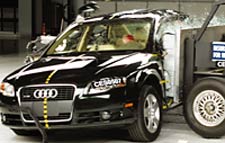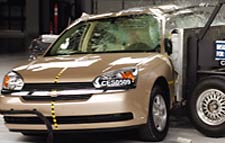ARLINGTON, VA - Among five 2005 model mid-size sedans, the Audi A4 with standard side airbags and the Chevrolet Malibu equipped with optional side airbags earn good ratings. They also earn the "best pick" designation in side impact crash tests recently conducted by the Insurance Institute for Highway Safety. The Volvo S60 earns the second highest rating of acceptable. The Suzuki Verona and Nissan Maxima are marginal. No vehicle in this group is rated poor.
The A4, which also is a "best pick" in the Institute's frontal offset crash test, becomes only the second car to earn this designation in both tests. Along with the Saab 9-3, it's a "double best pick."
"The Institute's side impact test is severe, reflecting what happens when vehicles are hit in the side by a pickup or SUV," says Institute chief operating officer Adrian Lund. "These latest test results show that more and more manufacturers are improving their vehicles to better protect occupants in side impact crashes."
The Institute now rates nine mid-size car designs good for side impact protection.

The Audi A4 (above) is a "double best pick." That is, it earns the Institute's "best pick" designation in both front and side crash tests. The Chevrolet Maulbu with optional side airbags (below) earns this designation for side impact crash test performance. This represents an improvement compared with the 2004 model Malibu, which was rated acceptable for side impact protection.

Testing of the A4 and S60 was delayed from the Institute's first round of side tests of mid-size cars conducted last year. The automakers asked for the delay because design changes were under way to improve side impact protection. The Maxima test also was delayed because of planned design changes, but those changes weren't implemented. The Verona and Malibu were retested to update results from last year because the manufacturers added new side airbags, which are standard on the Verona and optional on the Malibu.
Five more mid-size models will be tested in side impacts later this year. The Acura TSX, BMW 3 series, and Infiniti G35 will have new design features added to improve side impact protection. The completely redesigned Lexus IS 300 and Volkswagen Passat will be introduced later in 2005.
Institute test is more challenging than federal test: In the Institute's side impact test, a moving deformable barrier strikes the driver side of a passenger vehicle at 31 mph. The barrier weighs 3,300 pounds and has a front end that is shaped to simulate the front end of a typical pickup or SUV. In each side-struck vehicle are two instrumented dummies the size of a small (5th percentile) woman, one positioned in the driver seat and one in the rear seat behind the driver.
The federal government uses a barrier that represents the front end of a car. This barrier was developed in the early 1980s when cars represented most of the vehicles on the road. The height of the barrier's front end is below the heads of the dummies that measure injury risks in side-struck vehicles. These federal tests don't assess the risks of head injury from impacts with vehicles like SUVs and pickups.
The Institute's barrier is 12 inches taller and rides 4 inches higher off the ground. The top of it is at the same level as the heads of the dummies in the cars that are being tested. This is the scenario in real-world side impact crashes where occupants' heads often are struck by the intruding hood of a striking SUV or pickup truck.
Malibu improves: When the Institute tested the 2004 Chevrolet Malibu with optional side airbags, the car earned an acceptable rating.
"The 2004 model had optional curtain-style head airbags, but protection of the chest and abdomen wasn't good," Lund says. "The optional curtain did a good job of keeping injury measures on the heads of the dummies low, but torso injury measures for the driver dummy were high. This means that in a real-world crash of similar severity, rib fractures and internal organ injuries would be possible. This kept the 2004 Malibu with the optional curtain airbags from earning a good rating in the side impact test."
For the 2005 model year General Motors added torso airbags for front-seat occupants to improve protection of the chest and abdomen with the curtain airbags as an optional airbag package. In the test of the model with these new airbags all injury measures were low. In a similar real-world crash there would be a low risk of any significant injuries to the driver or rear passenger.
"This is very good performance, and the 2005 Malibu with side airbags is a 'best pick' for side crash protection," Lund says. "The results also show that you don't have to buy an expensive luxury car to get good protection for your family in a serious crash."
Based on the Institute's front, side, and rear impact tests, the Malibu with optional side airbags and Volkswagen's new Jetta with standard side airbags are the Institute's two highest rated moderately priced mid-size cars overall. The 2005 Malibu without the optional airbags is rated poor in the side impact test.
Volvo is acceptable: The S60's performance was not as good as the A4's or Malibu's. With the standard curtain airbags, head protection was good. But forces on the driver dummy's pelvis were high.
"Even though the S60 has standard torso airbags for front-seat occupants along with the curtains, a fractured pelvis for the driver would be likely in a real-world crash like this," Lund says. "Volvo still has some work to do to improve the S60's performance."
Side airbags are important, but so is good structure: The results for the Verona and Maxima show that vehicles with weak side structures are unlikely to provide effective protection in serious side crashes, even if they're equipped with head-protecting airbags. Both of these cars earned good ratings for driver head protection because of the standard side airbags, but the marginal performances of their structures contributed to high forces elsewhere on the driver dummies in both cars and on the rear dummy in the Verona.
Although the Verona is rated marginal overall, its performance is an improvement compared with the 2004 model. Side airbags weren't available in 2004, and the car's performance was poor in large part because the driver dummy's head was struck by the intruding barrier, which produced high head accelerations. For the 2005 model year, Suzuki added standard combination head/torso airbags that deploy from the side of the front seats. This time head protection for the driver was good, and forces on the driver dummy's torso were reduced. "Suzuki should be commended for making side airbags standard in this relatively inexpensive car," Lund says.
How vehicles are evaluated: Each vehicle's overall side evaluation is based on injury measures recorded on two instrumented SID-IIs dummies, assessment of head protection countermeasures, and the vehicle's structural performance during the impact. Injury measures obtained from the two dummies, one in the driver seat and the other in the rear seat behind the driver, are used to determine the likelihood that a driver and/or passenger in a real-world crash would have sustained serious injury to various body regions. The movements and contacts of the dummies' heads during the crash also are evaluated. This assessment is more important for seating positions without head-protecting airbags which, assuming they perform as intended, should prevent injurious head contacts. Structural performance is based on measurements indicating the amount of B-pillar intrusion into the occupant compartment. Some intrusion into the compartment is inevitable in serious side impacts, but any intrusion that does occur should be uniform both horizontally and vertically and shouldn't seriously compromise the driver or passenger space.




